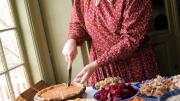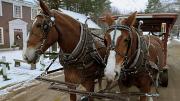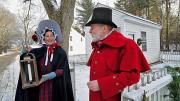The colder months might be the ideal time to visit Old Sturbridge Village. The craftspeople—blacksmiths, tinners, potters, and coopers—ply their trades as other costumed interpreters bring early American history “to life,” yet the crowd of visitors has thinned. What’s more, Thanksgiving is celebrated throughout November, and for Christmas, there are carolers, Yule logs, roasting chestnuts, and candlelit tours.
The museum, an hour’s drive from Cambridge, highlights daily life in New England communities between 1790 and 1840. Even then, Thanksgiving was a big deal. “The Puritans and their descendants didn’t celebrate Christmas, so this was the time people got together,” says village communications director Michael Arnum. Visitors can watch preparations for feasts of turkey, and meat or squash pies.
Two new exhibits are also open during November. “Armed & Equipped: Firearms and the Militia in New England, 1790-1840” highlights the village’s collection of weaponry, uniforms, and other artifacts. “Planed, Grained, and Dovetailed: Cabinetmaking in Rural New England” delves into the critical nineteenth-century industry through woodworking tools, techniques, and stories of prominent woodworkers, like Samuel Wing and Tilly Mead. Rare furniture is on display, along with cradles, coffins, drumsticks, boat frames, and beds.
That Puritan disdain for Christmas—not always celebrated as a Christian holiday back then, and often marked by drunkenness and dancing—prevailed in some semblance through several generations, slowly softening by the 1820s. (December 25 was officially named an American federal holiday in 1870.)
But Old Sturbridge Village fully decks the halls in December, resembling more of a Victorian town. It’s open Friday through Sunday, from 3 until 9 p.m., and the whole community is lit only by electric candles and strings of outdoor tree lights. There’s live music, along with horse-and-carriage rides, sing-alongs, children’s games, holiday food, a gingerbread-house contest, and traditional craft workshops. A model train set chugs along tracks in one gallery, and a miniature-sized “Little Town of Bethlehem” is on display at the Quaker Meeting House, where guides read the story of Christmas. They also lead village tours and talk about how modern Christmas traditions developed. Roasting chestnuts, for example, was already popular by the 1830s, but caroling came in later, says Arnum. “We also have a nightly tree-lighting ceremony—and, of course, Santa.”












